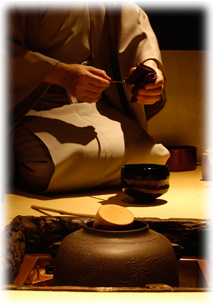 The custom of drinking tea started during the Heian Period.
The custom of drinking tea started during the Heian Period.
Originally, green tea was not using for tea ceremony at that time.
Tea for the moment was a kind of medicine purpose, not for enjoying as today.
During Kamakura period, “Maccha” (bitter green tea powder) became popular.
Between feudal lords, to hold a tea party was in fashion and this became a formal Tea ceremony bases.
Sennorikyu, the father of Sado (Tea ceremony), the pottery which has gorgeous looks declined. The main stream of Tea ceremony totally changed to simplified beauty.
This calls “Wabicha”This idea affected not only how and cups. It affected even food, place, and atmospheres even garden.
Then Wabicha developed until today with many schools.
Tea utensils are special tools for Tea ceremony.
The tools can be say a work of art and each of them made especially for Tea ceremony and it’s different from each schools.
Originally, Tea utensils were imported but seems like it didn’t fit to Japanese taste. People found beauty in simplicity and some points from crude work. This sense became the base of “WabiSabi”. During Warring States Period, the Tea utensils became a kind of reword, its value increased instead of imported Tea set.
This value changing of Japanese original Tea utensils with its mind affected to public market value, too.
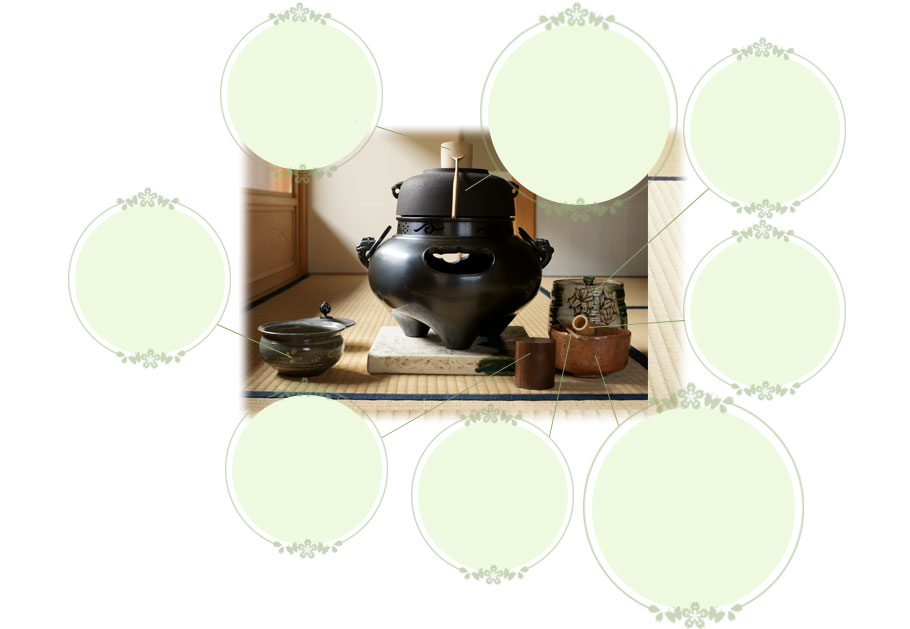
Hishaku
A tool to ladle out hot water from Chagama. Basically it makes by wood or bamboo.
Mizusashi
A pod to waste the water which cleaned and warmed a cup.
Chasen
Tea whisk is a tool of bamboo made to mix Maccha powder in a bowl. This is not an eggbeater.
Maccha Chawan
A special cup for tea. Of course it is to serve Tea but most of the time during a tea ceremony, its reason of existence is for appreciation. It should be adequate for tea ceremony (time, season, visitor, etc.)
Chashaku
Tea scoop to scoop up Maccha powder from Natsume. Normally, it keeps in a Bamboo container with signature of craftsman.
Natsume
A container for Maccha powder. It is a lacquer product which has high value as traditional crafts.
Kensi
A pod to waste the water which cleaned and warmed a cup.
Chagama
ATeakettle to prepare hot water. There is a Teakettle which has two parts which the basement is to burn charcoal calls “Huuro”. The base part one side is open. That direction should face to a visitor.
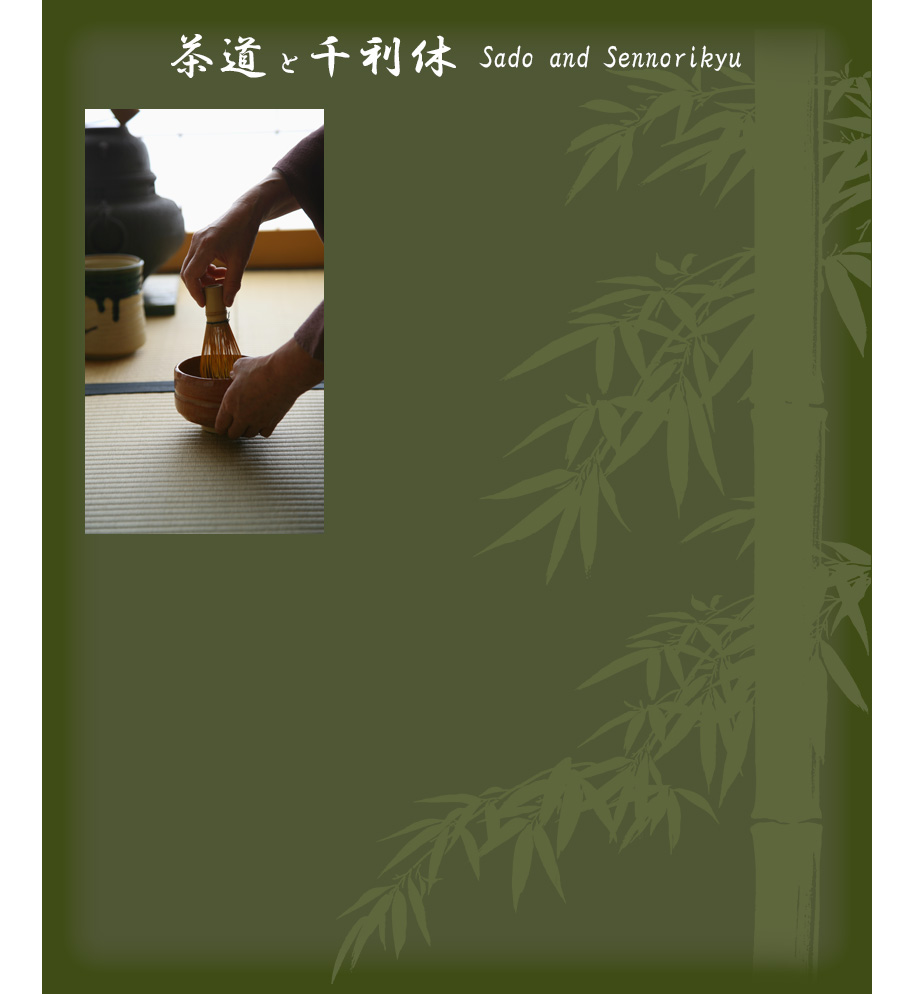
Sado is simple. Attend a visitor with tea based on a certain traditional rules.
It involved variable ideas Tea utensils, art work, tea room, garden, mind, attitude, religion, etc whole its development.
Sado is deeply related with Zen (one of the Buddhism denomination) and developed Wabi Sabi spiritual culture. Wabi, Sabi is acceptance of transience and imperfection which never fills and lives understanding that with modestly.
In Sado is important this Wabi Sabi mind and it is to concentration, to calm the mind, to reconsider by yourself, and to train the mind.
Sennorikyu adopt and fuse Wabi Sabi idea to Sado and established Wabicha so he calls as a father of Sado.
He left a presept which calls “Shiki Shichisoku”.
- ■Shiki
- Wa …… smooth relation
- Kei …… respect each othe
- Sei …… cleanness of looks and mind
- Jaku …… calmness
- ■Shichisoku
- 1. Prepare adequate tea for visitor. Think about your visitor and others.
- 2. Learn how to manage charcoal and learn things of life form there
- 3. Arrange flower as it should be. Don’t act; be naturally arranged by your self.
- 4. What kind of thing to keep comfort of the others. Consider things.
- 5. Beware time. Action in time makes margin and it make thing right.
- 6. Predict all problems and prepare for every assumed occasion not to be in a trouble.
- 7. Be equally for every person. There is no matter of position, age, relationship, and etc.
How do you think?
Sennorikyu says these are four and seven important things to realize. But it is difficult to realize instead of just writing.
The basic idea is keeping respects, don’t be too greedy. These are a basic idea in public society, too.
If Sado is to reach the summit this basic but essential idea, Sado is a really difficult to realize.
Please drink tea thinking these ideas when you try Sado in someday. Perhaps you’ll be closer to ideal of Sado.
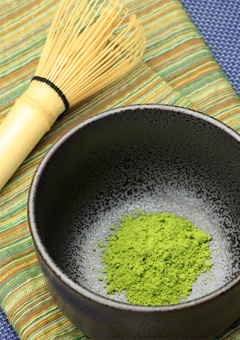 OTea of Tea ceremony calls “Maccha”. Maccha is a kind of Green tea and people think its taste is bitter.
OTea of Tea ceremony calls “Maccha”. Maccha is a kind of Green tea and people think its taste is bitter.
In Sado eat sweet before to drink tea. So Maccha taste removes and refresh you tongue.
There are Strong and weak Green tea in Sado. The Maccha of each type is prepares with different farming and production processes. Of course, its taste is different, too.
■About Maccha
Maccha is kind of Green tea as same as Gyokuro Green tea. Tea tree cultivate in shade. It makes without kneading and levitates. Cultivating in shade, the leaf will have more taste and richer body.
It has less bitterness and astringency. It says sweeter are the better and those use for Koicha.
■Usucha
Usucha use young 15-16 yrs old Green tea tree sprout which contains more tannic acid than Koicha. Its shade for cultivation is simple.
■Koicha
Koicha use matured Green tea tree more than 30 yrs old. The majority of trees are 80-100 yrs old. The soft sprouts of trees are strictly selected by farmer. Its shade is controlled with extreme care.

Virture of Maccha
The premier technical book of Green tea says it works for variable diseases. Green tea started drink as a kind of medicine.Especially, Green tea contains rich Vitamin A, Vitamin E and it doesn’t break down even in hot temperature.Maccha is the best way to absolve those minerals as with Maccha Green tea is able to partake of whole tea leaf.Many other ingredients contained by Green tea; caffeine which removes drowsiness and it has diuretic effect, catechin says works for high blood pressure and against allergies (it says about against allergies are depends on person). It is reasonable that Green tea was a kind of medicine.
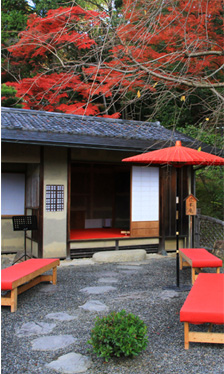
Chashitsu (Tea room) is a building, a host attend visitor at Tea ceremony and it uses only for that.
Its style of building is accomplished during Muromachi period to Azuchimomoyama period which we can say this is the most Japanese essential building.
Traditional Chashitsu locate in a garden “Roji (Satei)” which is totally separated from other buildings. The view and atomosphere of path to Chashitsu is a part of Tea ceremony’s treatment.
The entrance of Chashitsu calls “Nijiriguchi”, which is really small entrance (about 360 square centimeters only). The entrance has to bowing to enter which comes from Wabi Sabi idea. When you enter, an alcove will be in front of the person. Depends on the seasons and visitors the interior and equipments change for the best treatment.
Chashitsu has low roof and minimum windows to concentrate for the Tea ceremony. When visitors sit down, the host comes in from backdoor and starts the ceremony with his greeting. The real process is really complicated but the main steps are as the following; the host starts to prepare hot water and then people eat the meal. After that everybody get out from Chashitsu to Roji garden.
When you heard and totally finish the sound of drum goes back to Chashitsu and taste Koicha then Usucha. And people goes out form Chashitsu and the garden.
■Sennorikyu’s Chashitsu
Chashitsu’s functional designing also the work of Sennorikyu. He probe into the idea of Wabi Sabi Tea ceremony “Wabicha”.
There so many rules in Sado. If somebody makes blundering it is an impoliteness for both people who is related (host and others). Let us show some of the rules.
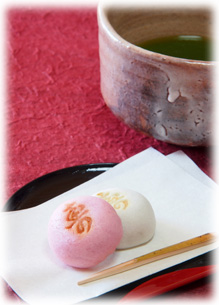 ■Don’t be late
■Don’t be late
Be in time but not too early. If you arrive too early perhaps it will trouble for the host.
He could be preparing for you but not yet.
If in front of the entrance is wet, that means preparation is ready. This calls “Uchimizu”.
It is important to act thoughtfully to have a nice time each other.
■Roji (Satei)
Roji or Satei is the garden where the Chashitsu locate.
Normally Roji make as a beautiful garden. This is a one of the good points of Tea ceremony passing through refreshable and calms down path.
Satei path has “Tobiishi” which is flat surface stones to step with little distance.
Even moss of the ground is calculated to treat people, please walk over the stones.
 ■Manners for sweets
■Manners for sweets
When starts Tea ceremony, the host greet first.
In general life, if a sweets comes before Green tea it should not eat before to finish Green tea. But in the case of Maccha, eat first sweets and then drink Maccha Green tea. There are“Omogashi” for Koicha and “Higashi” for Usucha. It is depends on but sometimes omitted Higashi.For many people Tea ceremony, sweets come on a tray and the main guest takes it then the others can take it. It should not eat until the main guest start to eat.If the sweet comes on a dish for each one, wait until the host says “please try”. Then people say “thanks for sweets”. After eating people enjoy the dish itself.
■Usucha
Usucha has several ways to drink.
When the tea cup comes in front of you, make a bow and ask to drink tea to each of them. Pick up the cup with right hand and put it over the left hand. And put the right hand to the side and bow again. Turn the cup 90 degree two times to face the cup to the opposite side. After drinking, clean where your put your mouse and clean the finger with a paper which you keeps in front of neck. Then turn the cup 90 degrees to the left to return it. The final step is pick up the cup with right hand and put it outside of the edge of Tatami mat.
■Appreciation of cup
When you put the cup on the outside of the Tatami mat edge, bow and don’t your hands free.
Keeping the hands over Tatami mat, start to appreciate the cup. Then pick up the cup and observe the bottom of the cup where a crest is.
When you pick up, don’t rise over your knee height. When you return it to the host. Turn it 90 degrees two times.

